
Her Majesty Queen Elizabeth II
Her Majesty Queen Elizabeth II's reign is the longest of any British monarch, lasting for 70 years from 1952 to 2022. Her monument at Queen's Park shows her sitting on a throne from the Senate of Canada which she used while reading the Speech from the Throne in 1977. It was sculpted by Canadian artist Ruth Abernethy and unveiled in 2023.

Notre Place Monument
The first monument dedicated to the province’s Franco-Ontarians was unveiled on the grounds of Queen’s Park in 2018. Titled “Notre place” (Our Home), the monument recognizes the key role played by the Francophone community in shaping Ontario’s history and building a modern, open and inclusive society.
The monument is a public space where a series of long, thin columns of various lengths clustered together symbolize the concept of both a journey and a gathering place.
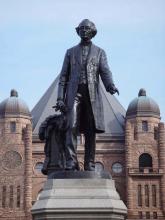
Sir John A Macdonald (1815 - 1891)
Sir John A. Macdonald was the first Prime Minister of Canada. As a Father of Confederation, his work on the British North America Act, passed in 1867, helped shape Canada into a new nation. This monument was created by Hamilton MacCarthy and unveiled in 1894.
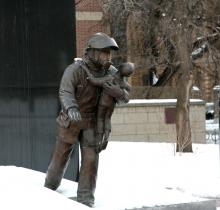
Ontario Firefighters Memorial
The Ontario Firefighters Memorial, situated at the northeast corner of Queen’s Park Crescent and College Avenue, was unveiled in 2005 and is dedicated to Ontario firefighters who died in the line of duty. Designed by sculptor Siggy Puchta, the base of the memorial is in the shape of a red Maltese Cross, an international symbol for firefighting.
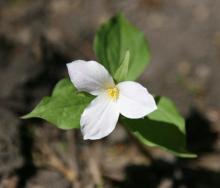
The White Trillium – Trillium Garden
A wildflower that blooms in late April and early May in woodlots throughout the province, the white trillium is also Ontario’s official floral emblem. It has three distinct leaves and petals, and should not be picked due to its delicate root system.
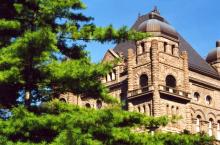
Eastern White Pine
In 1984, the eastern white pine was declared Ontario’s official tree and became a provincial symbol. Chosen because it was an important source of income and trade to early settlers of the province, it remains a valuable resource today.
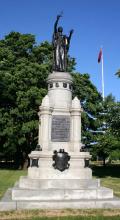
Northwest Rebellion Monument
The Northwest Rebellion Monument honours those who fell on the battlefields during the 1885 rebellion led by Louis Riel, a Métis who fought for native settlement and farming rights. Unveiled in 1895, it was Walter Allward’s first publicly-commissioned work, completed when he was just 19 years old.

Ontario Police Memorial
Dedicated in 2000, the Ontario Police Memorial honours the province’s police officers who lost their lives while serving the public. The monument consists of two bronze statues depicting male and female officers in duty dress standing atop a granite pedestal. Designed by artist Siggy Puchta, the memorial is located across the road from the Legislative Building on the grounds of the Whitney Block.
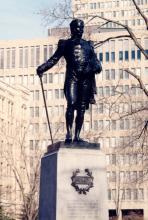
Lieutenant Governor John Graves Simcoe (1752 - 1806)
John Graves Simcoe served as the first Lieutenant Governor of Upper Canada (later Ontario) from 1791 to 1796. He founded the Legislature at Newark (Niagara-on-the-Lake), later moving it to York (Toronto). During his brief stay in the new colony, he established the court system, abolished slavery, and opened settlement to areas north of York (Toronto) by building Yonge Street. Walter Allward created this sculpture in 1903.
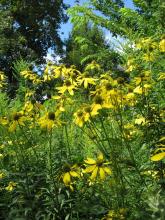
Native Species Garden
The trees, flowers and shrubs planted in this garden are all native to Ontario. Among the plantings found here are a hackberry tree, eastern white cedars, and native perennial flowers.
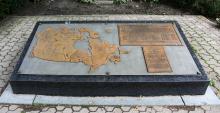
Post One Monument
The Post One monument was unveiled in 1967 by the Ontario Government to commemorate Canada’s centennial. It also functions as a precisely-located geodetic survey marker used by surveyors to take measurements. Sunk in the walkway in front of the monument is a time capsule that will be opened in 2067.
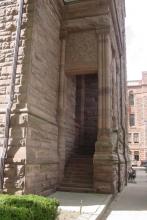
Staircase to Nowhere
The Staircase to Nowhere is located at the northeast corner of the building and is a set of stairs that lead to a blocked entrance. This entrance once provided public access to the Ontario Department of Immigration.
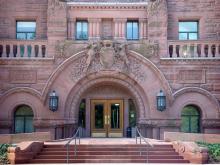
Ontario’s Coat of Arms
Above the north entrance of the building is a sandstone carving of Ontario’s Coat of Arms. Granted Royal Warrant in 1909, the shield of arms consists of three maple leaves and the Cross of St. George. Animals common to Ontario make up the crest – the black bear above the shield and the moose and deer on either side. The Latin motto underneath, Ut incepit fidelis sic permanet, translates to “loyal she began, loyal she remains”.
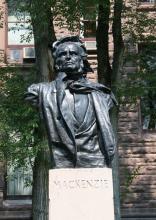
William Lyon Mackenzie (1795 - 1861)
William Lyon Mackenzie’s frustrated demands for democratic change in Upper Canada during the 1830s led him to organize a rebellion against the Upper Canadian government in 1837. His struggle for reform later inspired others to introduce change less radically. This allegorical monument reflecting his idealism was designed by Walter Allward.
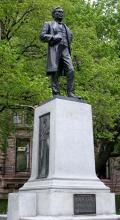
Sir Oliver Mowat (1820 - 1903)
In office for 24 years, from 1872 to 1896, Sir Oliver Mowat was Ontario’s longest-serving Premier. He advocated for provincial rights and introduced many social reforms. Mowat also served briefly in the Senate before being appointed Lieutenant Governor of Ontario in 1897. This monument was unveiled in 1905 and designed by Walter Allward.

Afghanistan Memorial
Unveiled next to the Ontario Veterans’ Memorial in 2020, the Afghanistan Memorial honours the over 40,000 Canadians who served during the mission in Afghanistan from 2001 to 2014. The memorial includes a bronze component in a folded and ribbon-like form. When viewed from the north side, the monument appears as a silhouette of the mountains east of Panjwai, Afghanistan, which Canadian soldiers saw as the backdrop from the Forward Operating Base at Masum Ghar. The memorial also includes a stone from an Inukshuk dedicated to the fallen soldiers that was erected by Canadian soldiers at Kandahar Airfield in Afghanistan.
Ontario Veterans' Memorial and Afghanistan Memorial Brochure (PDF)
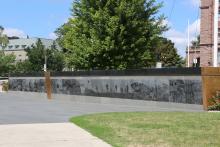
Ontario Veterans’ Memorial
The Ontario Veterans’ Memorial, completed in 2006, commemorates the participation of the province’s citizens in military campaigns from Canadian Confederation (1860s) to recent peacekeeping missions. The 30 metre long (100 feet) memorial featuring scenes etched in granite, was designed by Canadian artist Allan Harding Mackay and landscape architectural firm Phillips Farevaag Smallenberg. The wall is also inscribed with text written by poet Jane Urquhart and military historian Professor Jack Granatstein.
Ontario Veterans' Memorial and Afghanistan Memorial Brochure (PDF)
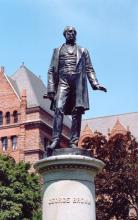
George Brown (1818 - 1880)
George Brown was one of Canada’s Fathers of Confederation and the founder of the Globe newspaper. Brown was a Reform politician whose political views differed greatly from Sir John A. Macdonald’s. This statue, sculpted by English artist C.B. Birch, was placed on the grounds in 1884 prior to the construction of the Legislative Building.
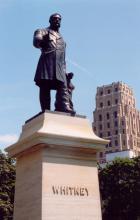
Sir James Pliny Whitney (1843 - 1914)
Elected Ontario Premier four times, Sir James Pliny Whitney served in office from 1905 to 1914. Public electricity was introduced in Ontario during his administration. The statue was sculpted by Hamilton MacCarthy and unveiled in 1927. The Whitney Block, a government building located on the east side of Queen’s Park Crescent, is named for the former Premier. It was constructed during the 1920s of Ontario materials such as limestone, dolomite, and marble, to showcase the province’s natural resources. The base of the Sir James Whitney statue is made of limestone. Look closely and you can see small fossils known as crinoids.
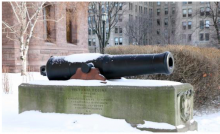
Russian Cannons
The two Russian cannons outside the Legislative Building entrance were captured by the British during the Crimean War and sent to Toronto in 1859 as a gift from Queen Victoria. Cannons such as these were melted down to supply metal for Victoria Cross medals, the highest military decoration awarded by the British Government for acts of valour in battle. The cannons were originally positioned at the south end of the park where Sir John A. Macdonald's monument is now located, and were moved in front of the Legislative Building upon its completion in 1892.
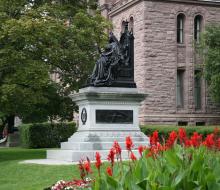
Her Majesty Queen Victoria
Her Majesty Queen Victoria ruled from 1837 to 1901. At nearly 64 years, her reign remains the second-longest of any British monarch after Her Majesty Queen Elizabeth II. Queen’s Park was named in Her honour in September 1860 by Her son, the Prince of Wales (later Edward VII). The Province of Ontario purchased this monument, designed by Mario Raggi, in 1902.
John Sandfield Macdonald (1812-1872)
Ontario’s first Premier, John Sandfield Macdonald, led a coalition government known as the Patent Combination from 1867 to 1871. Although appointed to the position by Sir John A. Macdonald, his party went on to win Ontario’s first general election, defeating George Brown’s Reformers. This monument, sculpted by Walter Allward, was unveiled in 1909.
Her Majesty Queen Elizabeth II's reign is the longest of any British monarch, lasting for 70 years from 1952 to 2022. Her monument at Queen's Park shows her sitting on a throne from the Senate of Canada which she used while reading the Speech from the Throne in 1977. It was sculpted by Canadian artist Ruth Abernethy and unveiled in 2023.

The first monument dedicated to the province’s Franco-Ontarians was unveiled on the grounds of Queen’s Park in 2018. Titled “Notre place” (Our Home), the monument recognizes the key role played by the Francophone community in shaping Ontario’s history and building a modern, open and inclusive society.
The monument is a public space where a series of long, thin columns of various lengths clustered together symbolize the concept of both a journey and a gathering place.
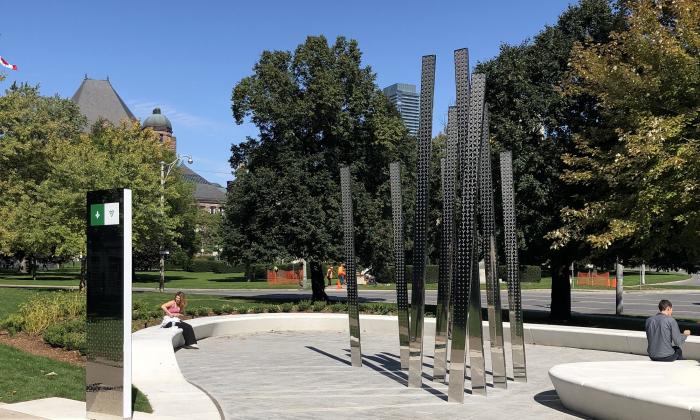
Sir John A. Macdonald was the first Prime Minister of Canada. As a Father of Confederation, his work on the British North America Act, passed in 1867, helped shape Canada into a new nation. This monument was created by Hamilton MacCarthy and unveiled in 1894.
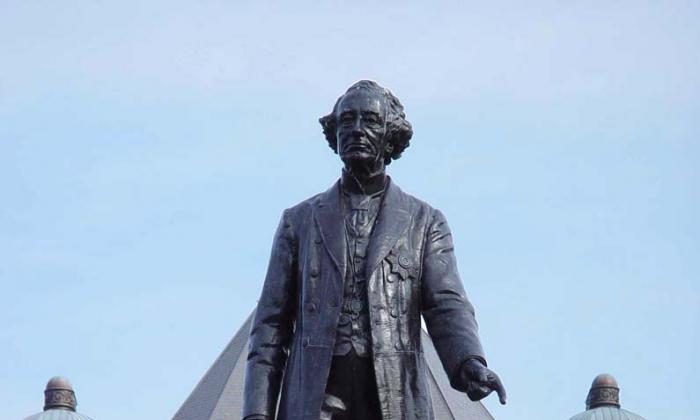
The Ontario Firefighters Memorial, situated at the northeast corner of Queen’s Park Crescent and College Avenue, was unveiled in 2005 and is dedicated to Ontario firefighters who died in the line of duty. Designed by sculptor Siggy Puchta, the base of the memorial is in the shape of a red Maltese Cross, an international symbol for firefighting.
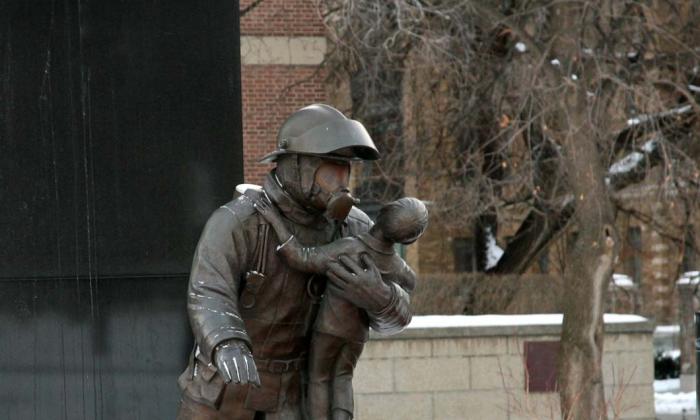
A wildflower that blooms in late April and early May in woodlots throughout the province, the white trillium is also Ontario’s official floral emblem. It has three distinct leaves and petals, and should not be picked due to its delicate root system.
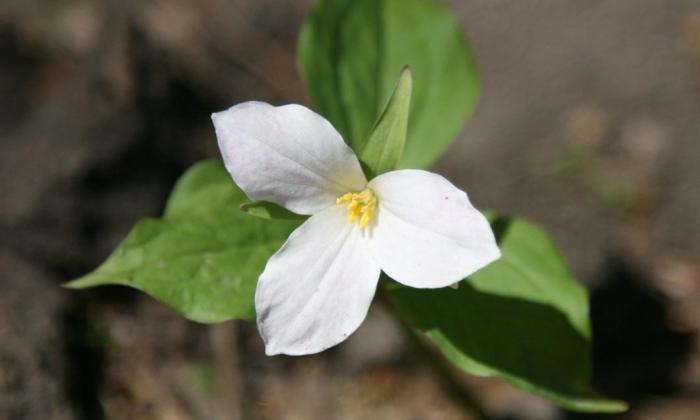
In 1984, the eastern white pine was declared Ontario’s official tree and became a provincial symbol. Chosen because it was an important source of income and trade to early settlers of the province, it remains a valuable resource today.
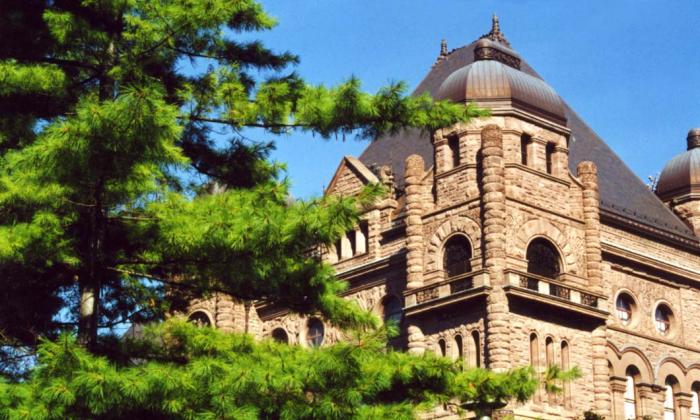
The Northwest Rebellion Monument honours those who fell on the battlefields during the 1885 rebellion led by Louis Riel, a Métis who fought for native settlement and farming rights. Unveiled in 1895, it was Walter Allward’s first publicly-commissioned work, completed when he was just 19 years old.
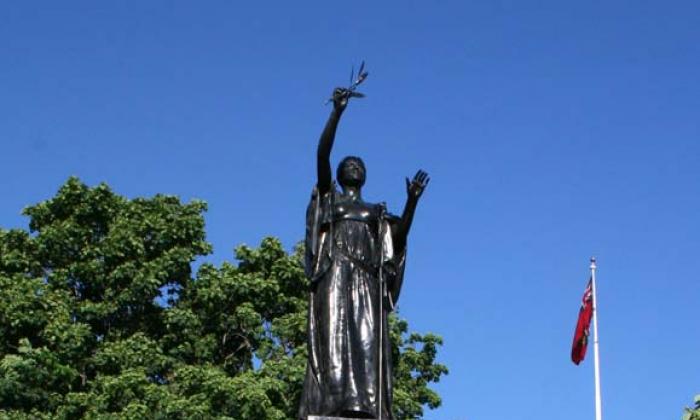
Dedicated in 2000, the Ontario Police Memorial honours the province’s police officers who lost their lives while serving the public. The monument consists of two bronze statues depicting male and female officers in duty dress standing atop a granite pedestal. Designed by artist Siggy Puchta, the memorial is located across the road from the Legislative Building on the grounds of the Whitney Block.
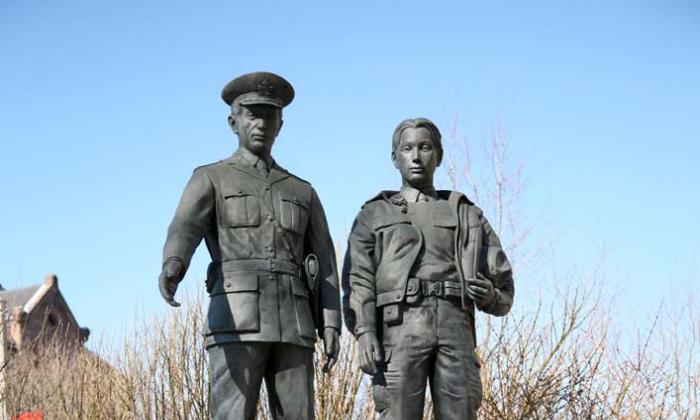
John Graves Simcoe served as the first Lieutenant Governor of Upper Canada (later Ontario) from 1791 to 1796. He founded the Legislature at Newark (Niagara-on-the-Lake), later moving it to York (Toronto). During his brief stay in the new colony, he established the court system, abolished slavery, and opened settlement to areas north of York (Toronto) by building Yonge Street. Walter Allward created this sculpture in 1903.
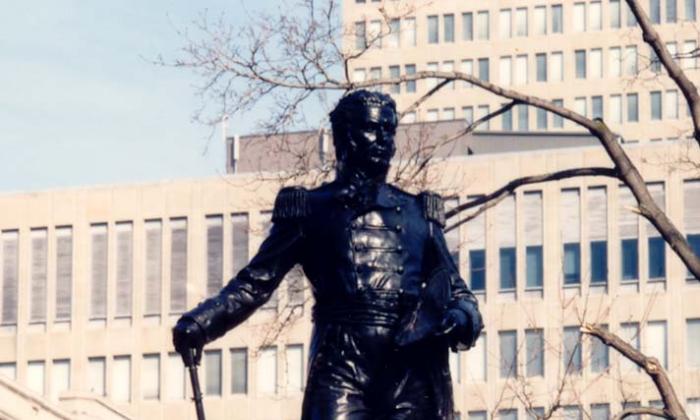
The trees, flowers and shrubs planted in this garden are all native to Ontario. Among the plantings found here are a hackberry tree, eastern white cedars, and native perennial flowers.
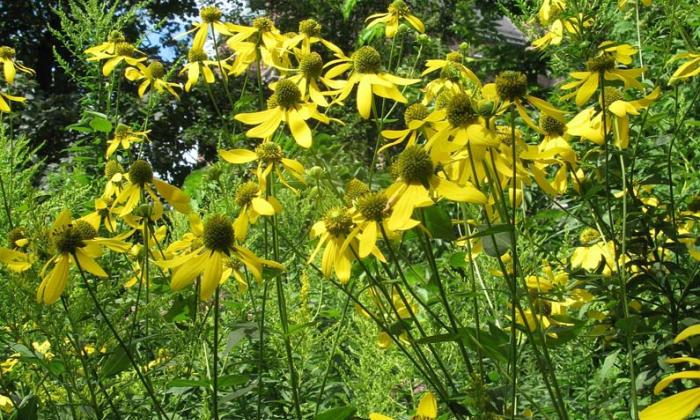
The Post One monument was unveiled in 1967 by the Ontario Government to commemorate Canada’s centennial. It also functions as a precisely-located geodetic survey marker used by surveyors to take measurements. Sunk in the walkway in front of the monument is a time capsule that will be opened in 2067.
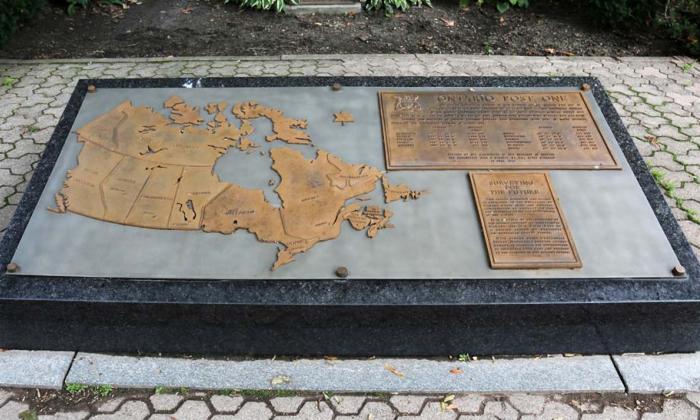
The Staircase to Nowhere is located at the northeast corner of the building and is a set of stairs that lead to a blocked entrance. This entrance once provided public access to the Ontario Department of Immigration.

Above the north entrance of the building is a sandstone carving of Ontario’s Coat of Arms. Granted Royal Warrant in 1909, the shield of arms consists of three maple leaves and the Cross of St. George. Animals common to Ontario make up the crest – the black bear above the shield and the moose and deer on either side. The Latin motto underneath, Ut incepit fidelis sic permanet, translates to “loyal she began, loyal she remains”.
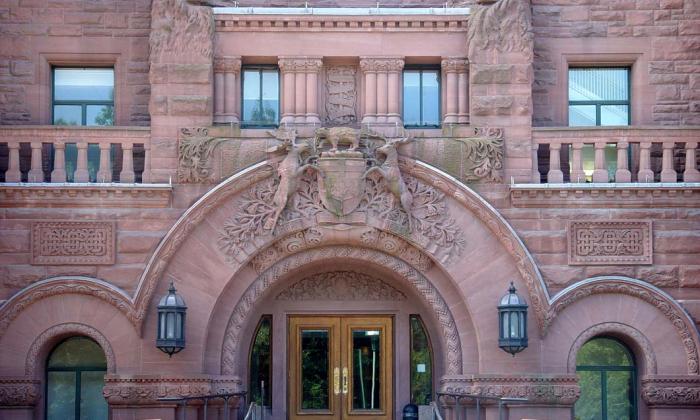
William Lyon Mackenzie’s frustrated demands for democratic change in Upper Canada during the 1830s led him to organize a rebellion against the Upper Canadian government in 1837. His struggle for reform later inspired others to introduce change less radically. This allegorical monument reflecting his idealism was designed by Walter Allward.
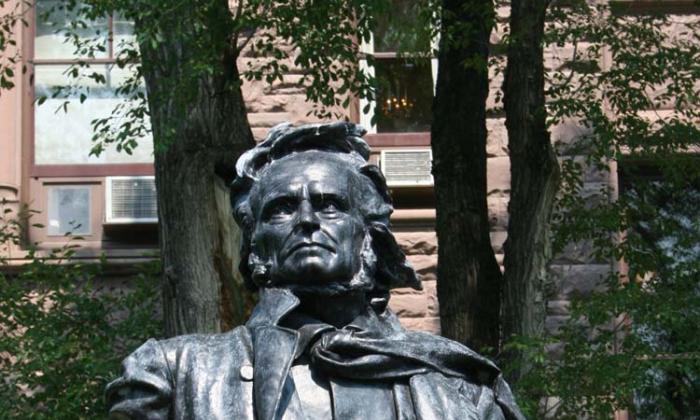
In office for 24 years, from 1872 to 1896, Sir Oliver Mowat was Ontario’s longest-serving Premier. He advocated for provincial rights and introduced many social reforms. Mowat also served briefly in the Senate before being appointed Lieutenant Governor of Ontario in 1897. This monument was unveiled in 1905 and designed by Walter Allward.
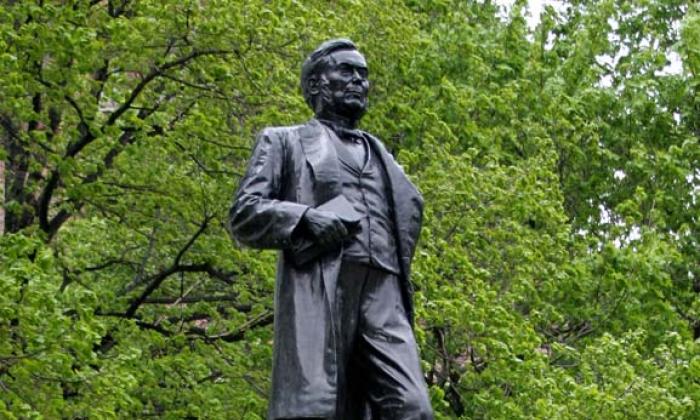
Unveiled next to the Ontario Veterans’ Memorial in 2020, the Afghanistan Memorial honours the over 40,000 Canadians who served during the mission in Afghanistan from 2001 to 2014. The memorial includes a bronze component in a folded and ribbon-like form. When viewed from the north side, the monument appears as a silhouette of the mountains east of Panjwai, Afghanistan, which Canadian soldiers saw as the backdrop from the Forward Operating Base at Masum Ghar. The memorial also includes a stone from an Inukshuk dedicated to the fallen soldiers that was erected by Canadian soldiers at Kandahar Airfield in Afghanistan.
Ontario Veterans' Memorial and Afghanistan Memorial Brochure (PDF)
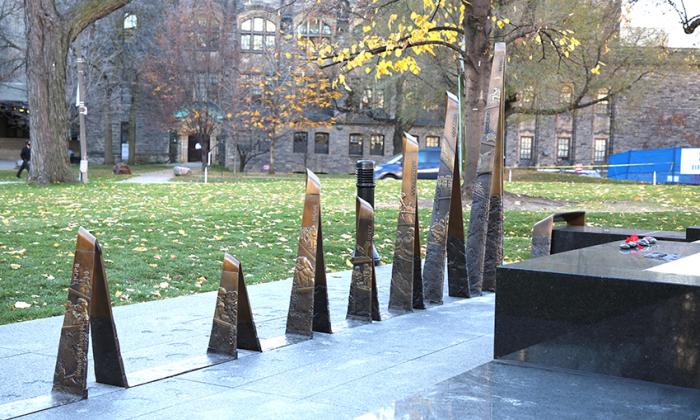
The Ontario Veterans’ Memorial, completed in 2006, commemorates the participation of the province’s citizens in military campaigns from Canadian Confederation (1860s) to recent peacekeeping missions. The 30 metre long (100 feet) memorial featuring scenes etched in granite, was designed by Canadian artist Allan Harding Mackay and landscape architectural firm Phillips Farevaag Smallenberg. The wall is also inscribed with text written by poet Jane Urquhart and military historian Professor Jack Granatstein.
Ontario Veterans' Memorial and Afghanistan Memorial Brochure (PDF)
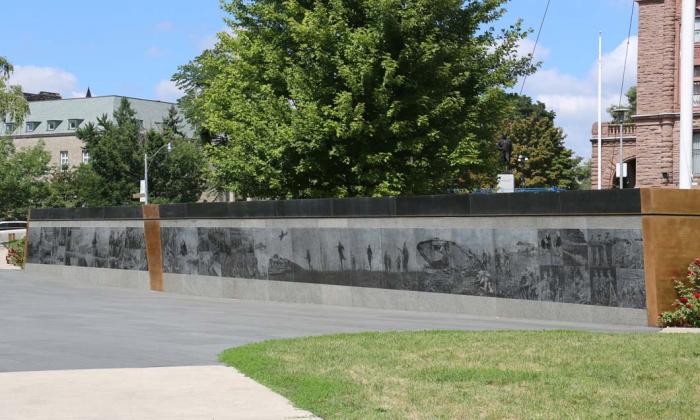
George Brown was one of Canada’s Fathers of Confederation and the founder of the Globe newspaper. Brown was a Reform politician whose political views differed greatly from Sir John A. Macdonald’s. This statue, sculpted by English artist C.B. Birch, was placed on the grounds in 1884 prior to the construction of the Legislative Building.
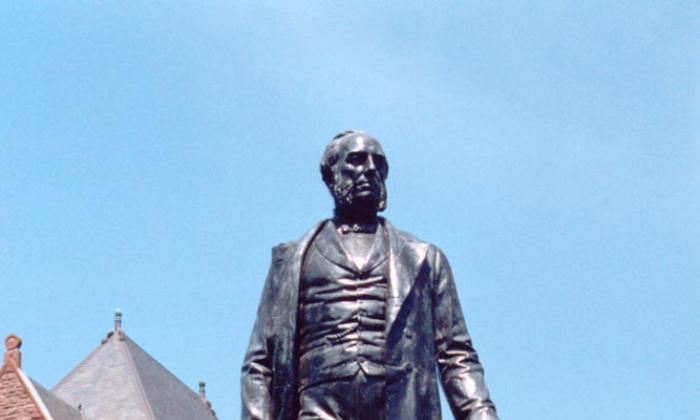
Elected Ontario Premier four times, Sir James Pliny Whitney served in office from 1905 to 1914. Public electricity was introduced in Ontario during his administration. The statue was sculpted by Hamilton MacCarthy and unveiled in 1927. The Whitney Block, a government building located on the east side of Queen’s Park Crescent, is named for the former Premier. It was constructed during the 1920s of Ontario materials such as limestone, dolomite, and marble, to showcase the province’s natural resources.
The base of the Sir James Whitney statue is made of limestone. Look closely and you can see small fossils known as crinoids.
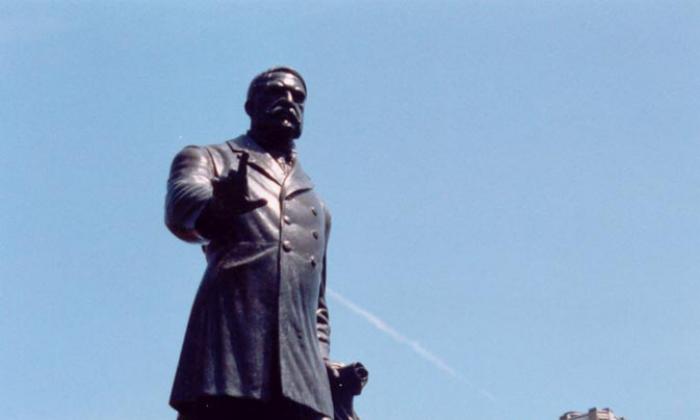
The two Russian cannons outside the Legislative Building entrance were captured by the British during the Crimean War and sent to Toronto in 1859 as a gift from Queen Victoria. Cannons such as these were melted down to supply metal for Victoria Cross medals, the highest military decoration awarded by the British Government for acts of valour in battle. The cannons were originally positioned at the south end of the park where Sir John A. Macdonald's monument is now located, and were moved in front of the Legislative Building upon its completion in 1892.
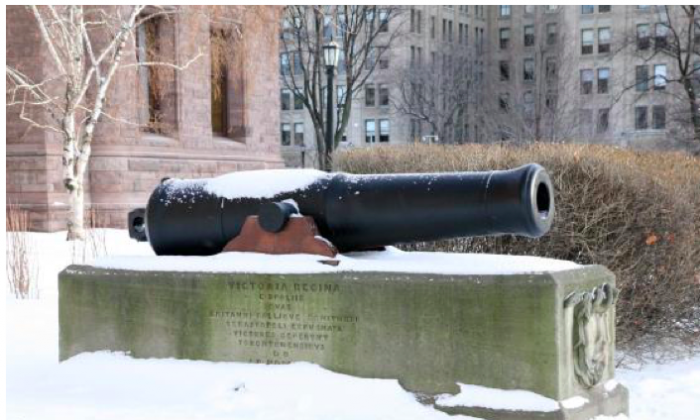
Her Majesty Queen Victoria ruled from 1837 to 1901. At nearly 64 years, her reign remains the second-longest of any British monarch after Her Majesty Queen Elizabeth II. Queen’s Park was named in Her honour in September 1860 by Her son, the Prince of Wales (later Edward VII). The Province of Ontario purchased this monument, designed by Mario Raggi, in 1902.
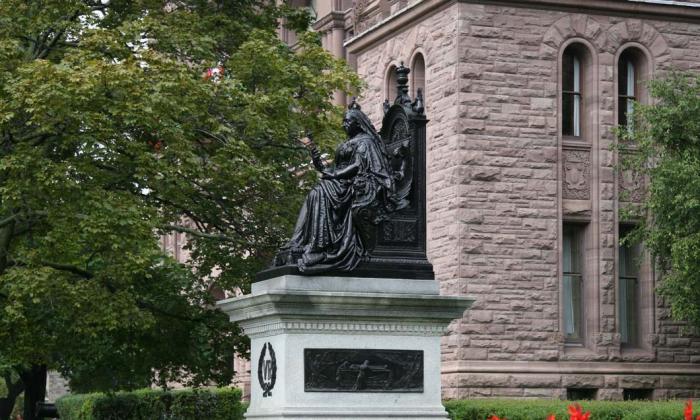
Ontario’s first Premier, John Sandfield Macdonald, led a coalition government known as the Patent Combination from 1867 to 1871. Although appointed to the position by Sir John A. Macdonald, his party went on to win Ontario’s first general election, defeating George Brown’s Reformers. This monument, sculpted by Walter Allward, was unveiled in 1909.

